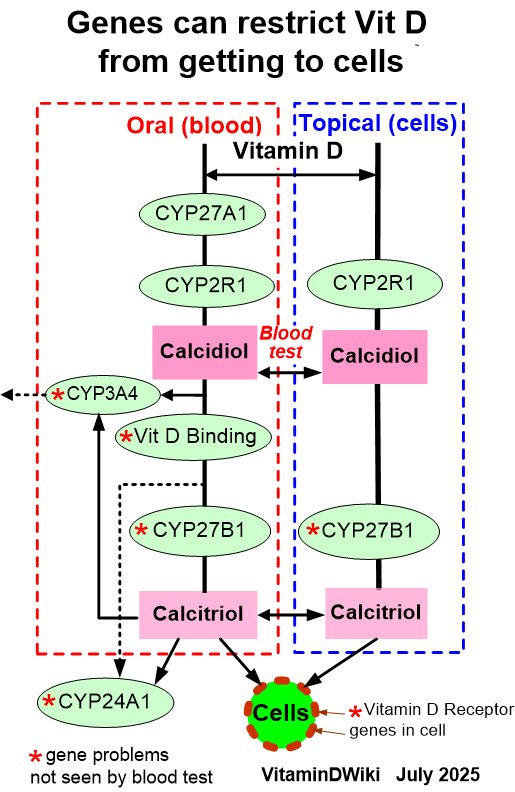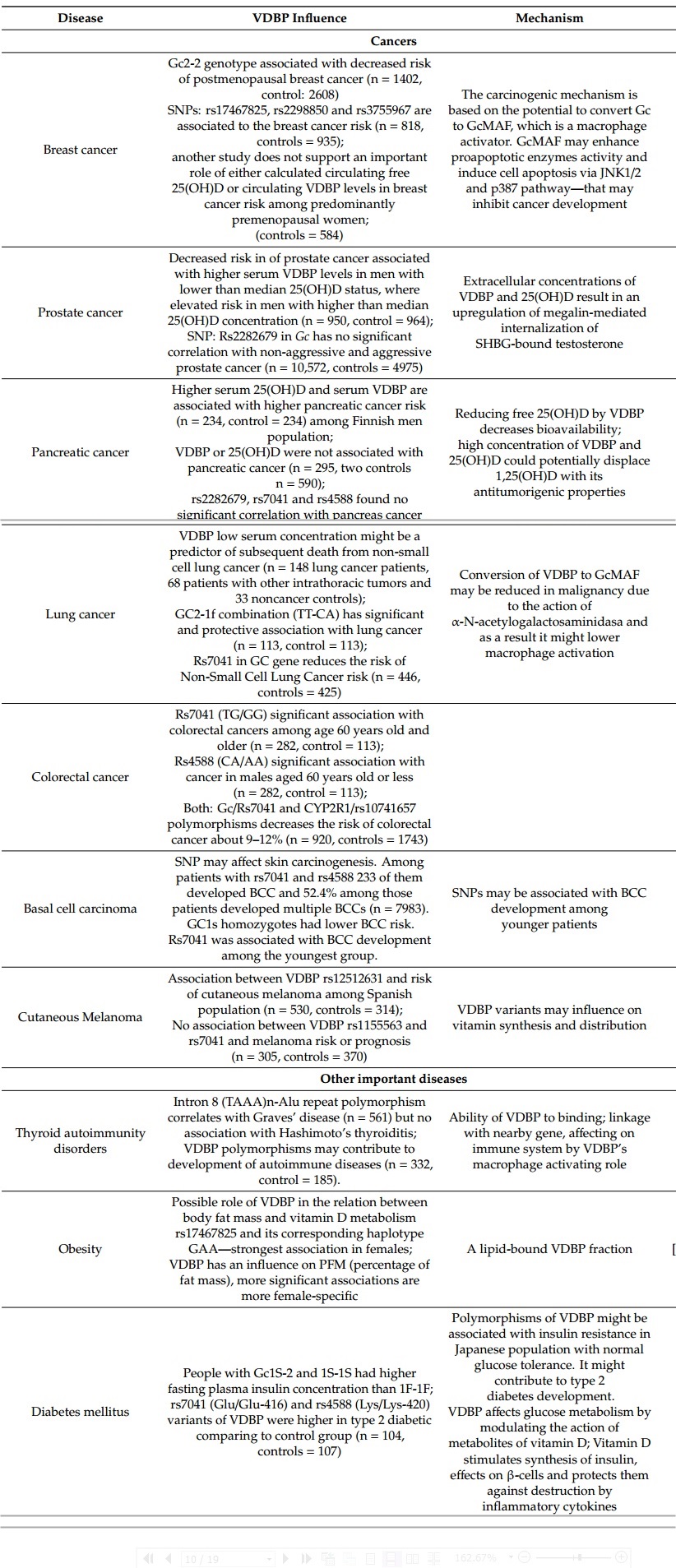Vitamin D Binding Protein
items in Vitamin D Binding Protein category
See also Vitamin D Receptor Genetics CYP27B1
Increased risk of health problems if poor VDBP
| **Increased | |
| Risk** | Health Problem |
| 11 X | Preeclampsia |
| 6.5X | T1D in SA Blacks |
| 6 X | Food Allergy |
| 5 X | PTSD |
| 4 X, 5X | Kidney Cancer |
| 4 X | Poor Response to Oral Vitamin D |
| 3 X | Ear infection |
| 2.8 X | MS |
| 2.5 X | Severe Autism |
| 2 X | Colorectal Cancer |
| 2 X | Prostate Cancer -in those with dark skins |
| 1.3 X | Infertility |
VDBP is NOT directly detected by vitamin D blood tests

MS and Vitamin D Binding Protein studies
{category}
TB and Vitamin D Binding Protein - studies
{category}
Breathing and Vitamin D Binding Protein - studies
{category}
Infant-Child and Vitamin D Binding Protein - studies
{category}
Pregnancy and Vitamin D Binding Protein - studies
{category}
Vitamin D Binding Protein and Its Gene Polymorphisms —The Risk of Malignant Tumors and Other Diseases - Oct 2020


VDBP studies
{category}
Low response to Vitamin D can be improved in many ways
No response to Vitamin D was 11 X more likely to have if poor Binding gene – Sept 2022
Non-oral Vitamin D should be a better form for MS, food allergy, PTSD, etc. – many studies
See also web
Meta-analysis of vitamin D-binding protein and cancer risk Sept 2015
"Results: We found a borderline decrease in cancer risk for subjects with high compared to low levels of DBP"
"We included 28 independent studies concerning: basal cell carcinoma, bladder, breast, colon-rectum, endometrium, liver, esophagus, stomach, melanoma, pancreas, prostate and kidney. "
Vitamin D Binding Protein mutations are not noticed by the Vitamin D Test – March 2024
Factors to take into account when interpreting 25-hydroxy-vitamin D serum levels
Acta Clin Belg. 2024 Mar 7:1-6. doi: 10.1080/17843286.2024.2327218 – PDF behind a $65 paywall
Joris R Delanghe 1, Marijn M Speeckaert 2 3, Thomas Maenhout 1
Background: Assessing vitamin D status, typically evaluated using serum or plasma 25-hydroxy vitamin D [25(OH)D] concentration, is complex because of various influencing factors.
Methods: Seasonality significantly affects intra-individual variability in 25(OH)D levels. This variation can be addressed by employing cosinor functions that are tailored to the geographical location of the patient to correct for seasonal effects. In addition to seasonality, genetic factors, such as DBP polymorphism and body composition, particularly adiposity, play crucial roles. Dialysis patients with DBP 2-2 phenotype exhibit higher vitamin D requirements. Genotyping/phenotyping of DBP allows for better tailored vitamin D supplementation. The lipid-soluble nature of vitamin D also interacts with plasma components such as serum triglycerides, which can influence vitamin D measurements. Adiposity, which is negatively correlated with vitamin D concentration, necessitates body mass-based mathematical adjustments for accurate vitamin D assessment in subjects with extreme BMI values.
Conclusions: Accordingly, vitamin D replacement therapy must be personalized, taking into account factors such as body size and seasonal variations, to effectively reach the target serum 25(OH)D concentrations.
Introduction (from DeepDyve)
Owing to a markedly increased interest in the role of vitamin D in human health, the determination of 25- hydroxy vitamin D [25(OH)D] in serum or plasma has become a frequently requested laboratory test [1 ]. This rise in popularity can be attributed not only to the growing recognition of the wide-ranging health implications of vitamin D [2,3] but also to significant advancements in the effectiveness of vitamin D analysis techniques [3].
The intraindividual biological variability (CVI) has been reported to be 4.7% for 25-hydroxy vitamin D. In contrast, interindividual variation (CVG), representing diverse homeostatic points among subjects within the same population, was significantly higher at 64.3% for 25(OH)D [4]. The calculated reference change value (RCV) for 25(OH)D was 18.0%. These data indicate that interindividual variation markedly surpasses intraindividual variation in 25(OH)D levels [4].
On top of the biological variation of 25(OH) vitamin D, in moderate and Arctic climates, vitamin D levels exhibit significant seasonal variability, primarily due to changes in sunlight exposure. This variability becomes more pronounced with increasing distance from the equator, with studies indicating a marked decrease in vitamin D synthesis in populations at higher latitudes. The biological mechanisms underlying this phenomenon, including the reduced capacity of the skin to synthesize vitamin D under lower UV conditions, warrant further discussion [5,6].
Vitamin D, a fat-soluble vitamin, relies on a specific transport protein, known as the vitamin D binding protein (DBP), for its circulation in the bloodstream. This binding protein plays a crucial role in the bioavail- abilitv and metabolic reoulation of vitamin D. nosino a complex challenge for interpreting the vitamin D status from serum or plasma 25(OH)D concentrations. The complexities of this relationship, particularly in different physiological and pathological states, emphasize the need for a more nuanced approach to vitamin D analysis [7].
Most clinical laboratories tend to oversimplify the interpretation of vitamin D status by comparing test results with generic 'summer' and 'winter' reference values. These seasonal reference values, which are often inadequately defined, fail to offer a comprehensive correction for individual variability and geographical differences, leading to potential misinterpretations in vitamin D status assessment. The scientific basis for these reference values, as well as alternative methodologies that might provide more accurate assessments, are areas ripe for exploration [8-10].
Most clinical laboratories tend to oversimplify the interpretation of vitamin D status by comparing test....
Studies of VDBP and diseases: Pregnancy 10, Skin - Dark 8, Breathing 7, Infant-Child 7, Multiple Sclerosis 6, Virus 6, Cardiovascular 6, Diabetes 5, Autoimmune 4, Cancer - Other 4, Obesity 4, Tuberculosis 4 – Jan 2024
Close Associations
